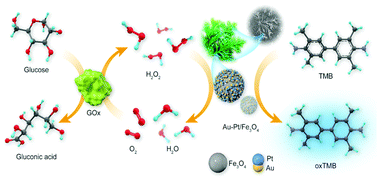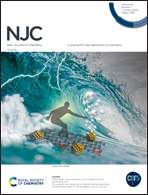Colorimetric detection of glucose by a hybrid nanomaterial based on amplified peroxidase-like activity of ferrosoferric oxide modified with gold–platinum heterodimer†
Abstract
The colorimetric detection of glucose using hybrid nanostructures is a rapidly growing research hotspot. In this work, we established a simple route for the synthesis of a class of multi-metal hybrid nanostructure materials and investigated their peroxidase-like performance for the colorimetric detection of glucose. The hybrid nanomaterial (Fe3O4@Au–Pt) incorporated ferrosoferric oxide nanoparticles (Fe3O4 NPs) and heterodimers composed of gold (Au) and platinum (Pt), which presents excellent morphology and structure. On the basis of our research, we constructed an easy and sensitive colorimetric sensor for the detection of glucose and hydrogen peroxide (H2O2), and the results indicated that the Fe3O4@Au–Pt hybrid nanomaterial possessed preferable peroxidase-like activity in comparison with other nanozyme materials and showing prominent selectivity for glucose detection. For H2O2, the sensor has a linear range of 0.05–120 μM and a relatively low limit of detection (LOD) of 0.018 μM. For glucose, the linear range is 0.05–140 μM with an LOD of 0.025 μM. It is envisioned that these hydrophilic hybrid nanostructures will be widely applied in sensing target analytes, biomedical diagnosis, and therapeutic applications in the future by taking advantage of their specific structure and excellent catalytic performance.



 Please wait while we load your content...
Please wait while we load your content...